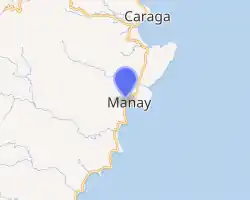Manay, Davao Oriental
Manay ([mɐnaɪ], also spelled Man-ay), officially the Municipality of Manay (Cebuano: Lungsod sa Manay; Tagalog: Bayan ng Manay), is a 2nd class municipality in the province of Davao Oriental, Philippines. According to the 2015 census, it has a population of 42,690 people. [3]
Manay | |
|---|---|
| Municipality of Manay | |
 Seal | |
 Map of Davao Oriental with Manay highlighted | |
OpenStreetMap 
| |
.svg.png.webp) Manay Location within the Philippines | |
| Coordinates: 7°13′N 126°32′E | |
| Country | |
| Region | Davao Region (Region XI) |
| Province | Davao Oriental |
| District | 1st District |
| Barangays | 17 (see Barangays) |
| Government | |
| • Type | Sangguniang Bayan |
| • Mayor | Antero Manolo L. Dayanghirang, Jr. |
| • Vice Mayor | Japhet M. Quibo |
| • Representative | Corazon N. Malanyaon |
| • Electorate | 26,820 voters (2019) |
| Area | |
| • Total | 418.36 km2 (161.53 sq mi) |
| Elevation | 313 m (1,027 ft) |
| Population | |
| • Total | 42,690 |
| • Density | 100/km2 (260/sq mi) |
| • Households | 9,528 |
| Economy | |
| • Income class | 2nd municipal income class |
| • Poverty incidence | 35.21% (2015)[4] |
| • Revenue | ₱138,557,067.03 (2016) |
| Time zone | UTC+8 (PST) |
| ZIP code | 8202 |
| PSGC | |
| IDD : area code | +63 (0)87 |
| Climate type | tropical rainforest climate |
| Native languages | Davawenyo Surigaonon Cebuano Kalagan Kamayo Mandaya |
| Website | manay |
It is also pronounced as Man-ay.
Barangays
Manay is politically subdivided into 17 barangays.
- Capasnan
- Cayawan
- Central (Poblacion)
- Concepcion
- Del Pilar
- Guza
- Holy Cross
- Mabini
- Manreza
- Old Macopa
- Rizal
- San Fermin
- San Ignacio
- San Isidro
- Taocanga
- Zaragosa
- Lambog
Demographics
| Year | Pop. | ±% p.a. |
|---|---|---|
| 1918 | 5,335 | — |
| 1939 | 11,528 | +3.74% |
| 1948 | 11,097 | −0.42% |
| 1960 | 15,813 | +2.99% |
| 1970 | 21,114 | +2.93% |
| 1975 | 24,304 | +2.86% |
| 1980 | 25,534 | +0.99% |
| 1990 | 33,686 | +2.81% |
| 1995 | 35,428 | +0.95% |
| 2000 | 36,697 | +0.76% |
| 2007 | 38,067 | +0.51% |
| 2010 | 40,577 | +2.35% |
| 2015 | 42,690 | +0.97% |
| Source: Philippine Statistics Authority [3] [5] [6][7] | ||
Climate
Manay has a tropical rainforest climate (Af) with heavy to very heavy rainfall year-round.
| Climate data for Manay | |||||||||||||
|---|---|---|---|---|---|---|---|---|---|---|---|---|---|
| Month | Jan | Feb | Mar | Apr | May | Jun | Jul | Aug | Sep | Oct | Nov | Dec | Year |
| Average high °C (°F) | 30.3 (86.5) |
30.3 (86.5) |
31.3 (88.3) |
31.9 (89.4) |
31.9 (89.4) |
31.4 (88.5) |
31.3 (88.3) |
31.6 (88.9) |
31.8 (89.2) |
31.9 (89.4) |
31.6 (88.9) |
30.8 (87.4) |
31.3 (88.4) |
| Daily mean °C (°F) | 26.0 (78.8) |
26.0 (78.8) |
26.7 (80.1) |
27.2 (81.0) |
27.4 (81.3) |
27.0 (80.6) |
26.9 (80.4) |
27.1 (80.8) |
27.1 (80.8) |
27.3 (81.1) |
27.0 (80.6) |
26.5 (79.7) |
26.9 (80.3) |
| Average low °C (°F) | 21.8 (71.2) |
21.8 (71.2) |
22.1 (71.8) |
22.6 (72.7) |
23.0 (73.4) |
22.7 (72.9) |
22.5 (72.5) |
22.6 (72.7) |
22.5 (72.5) |
22.7 (72.9) |
22.5 (72.5) |
22.3 (72.1) |
22.4 (72.4) |
| Average rainfall mm (inches) | 422 (16.6) |
323 (12.7) |
252 (9.9) |
182 (7.2) |
156 (6.1) |
136 (5.4) |
122 (4.8) |
106 (4.2) |
100 (3.9) |
153 (6.0) |
184 (7.2) |
323 (12.7) |
2,459 (96.7) |
| Source: Climate-Data.org[8] | |||||||||||||
References
- Municipality of Manay | (DILG)
- "Province: Davao Oriental". PSGC Interactive. Quezon City, Philippines: Philippine Statistics Authority. Retrieved 12 November 2016.
- Census of Population (2015). "Region XI (Davao Region)". Total Population by Province, City, Municipality and Barangay. PSA. Retrieved 20 June 2016.
- "PSA releases the 2015 Municipal and City Level Poverty Estimates". Quezon City, Philippines. Retrieved 12 October 2019.
- Census of Population and Housing (2010). "Region XI (Davao Region)". Total Population by Province, City, Municipality and Barangay. NSO. Retrieved 29 June 2016.
- Censuses of Population (1903–2007). "Region XI (Davao Region)". Table 1. Population Enumerated in Various Censuses by Province/Highly Urbanized City: 1903 to 2007. NSO.
- "Province of Davao Oriental". Municipality Population Data. Local Water Utilities Administration Research Division. Retrieved 17 December 2016.
- "Climate: Manay". Climate-Data.org. Retrieved 27 October 2020.
External links
- Manay Profile at PhilAtlas.com
- Philippine Standard Geographic Code
- Philippine Census Information
- Local Governance Performance Management System
This article is issued from Wikipedia. The text is licensed under Creative Commons - Attribution - Sharealike. Additional terms may apply for the media files.